► We pitch the turbocharged 911 Carrera against its rivals
► Mercedes-AMG GT S vs Jaguar F-Type R vs Porsche 911 Carrera S
► Full specifications rundown, performance and economy figures
Going turbo is the biggest change to the 911 since the flat-six began covering its modesty with a water jacket. With every new generation the Boxster/Cayman duo creep closer to assuming the mantle of Porsche’s true sports-car stars and the 911 edges closer to being the GT it never has been thus far.
But has it gone too far with the adoption of turbocharged power, a move that no other manufacturer has made without enduring some key sacrifices, most notably sound, urgency, and often both? That’s what we’re here on the Yorkshire moors to find out as the new 911 Carrera S takes on the AMG GT S and Jaguar F-type R.
But let’s park the doom-mongering for a second. If ever news of a sports car going down the turbo route was not a cause for worry, the 911 should be it. Porsche neither invented turbocharging, nor used it first on a road car, but after employing it to decimate the opposition in sports car racing, it came up with a brilliant forced-induction range-topping 911 Turbo in 1974, and has been making them ever since.
That’s Turbo with a capital T, Turbo as a brand and model name emblazoned along the rump. You’ll see no such references with the new brot-und-butter 911s, only the familiar Carrera and Carrera S monikers. Here, artificial aspiration is not a brand extension, but merely an enabler.
And what it enables the latest 911s to do is leave their predecessors as frog-eyed specs in the distance while sipping fuel at a rate that would make a hot hatch blush. Emissions targets have forced Porsche’s hand but switching to turbos has also delivered a huge shot in the arm for real-world performance that wouldn’t have been possible without wrecking the existing mpg numbers.
Slicing through evening A1 traffic on the way to North Yorkshire at a naughty cruise that feels like the minimum acceptable speed in a car this keen to make progress, the latest Carrera S is already making a friend in me. Of course there’s too much tyre noise, there always is in 911s, and the S’s 305mm rear boots are now 10mm wider than before. But it feels planted and responsive in unequal measure, happy to potter – and ready to pounce.
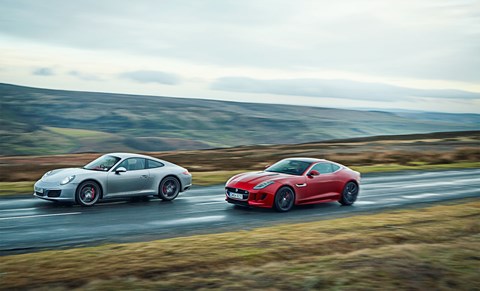
When the traffic slows, forcing you to lift then dip a toe back into the power, the throttle response is impressively crisp. Beyond that there’s a momentary pause before the real boost action arrives, but it’s chuffing nicely from 1700rpm, pulling hard from 2500rpm and – with this car’s sports exhaust switched to rowdy – making my neck hairs open a sleepy eye, if not exactly stand to attention. But in motorway driving the real benefit is the extra torque, which makes the loonnnng seventh gear in this car’s deliciously tactile manual transmission far more useable than it ever was.
The basic Carrera, which I always felt a little undernourished in the original 3.4-litre 991 guise, now comes with a 3.0-litre twin-turbo flat-six good for 365bhp, a 20bhp improvement allied to an additional 44lb ft of torque. That’ll set you back £76,412 before options, and it finally comes with the PASM adaptive dampers as standard. But most buyers step past to the Carrera S we’ve brought to today’s fight. In the S a £9445 premium pumps the same six up to a thick-set 414bhp and 369lb ft.
No surprise, given that the 911 was always in Jag’s crosshairs with the F-type programme, the R comes in very close on price. An inevitable trip to the options list for both (including choosing Porsche’s optional PDK ’box at £2388) will easily wipe out the £953 extra you’d pay for the Jag, but even if it didn’t, you might well consider the colossal 542bhp and 502lb ft ample compensation.
AMG’s GT is packing over 500bhp too, at least in S guise (the standard GT makes do with 456bhp to the S’s 503). But then it’d want to be given it costs £110,495. Owner Richard Bates’s Edition 1 is even pricier. Though mechanically identical to the S, it adds a fixed rear wing, rear diffuser, front splitter and carbon roof among other goodies, which bump the cost up to £122,745.
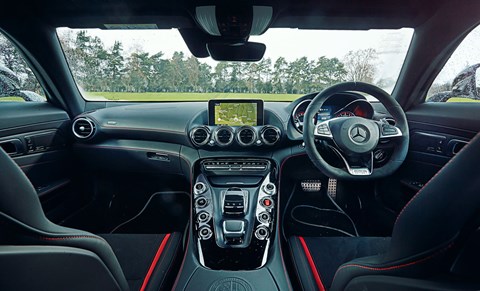
But it looks like it’s worth every penny, and since it costs a cool £50k less than the old gullwing-door SLS it effectively replaces, it probably is. Richard’s wife talked him out of/threatened to leave if he ordered the solarbeam yellow that topped his colour chart; designo diamond white was number two and it looks magnificent. Loud and louche, and brilliantly highlighting the Edition 1 spoiler and other details, the pearl paint covers flanks that are surprisingly unfussy by Mercedes standards and culminate in that 928-esque pinched rear with its reptilian stare.
Open the door, which swings conventionally rather than up and over, despite the GT sharing the old SLS’s chassis centre, and the cabin revealed is every bit as glamorous as the exterior hints at. Dropping into the red-and-black trimmed AMG sports seat you don’t notice the high sill that makes getting back out again slightly awkward. You’re too busy focusing on the HGV-sized centre console, you’re wondering why the gear selector seems almost behind you, why there’s so little room in here, and whether a couple of diplomatic flags at each corner of the prow in the distance might be good idea. Visibility is not a strong point in any direction.
It’s not that hot in the Jag either, a combination of rear quarter obstruction and high scuttle to blame. But it’s going to take more than not being able to see where you’re going to scupper the F-type’s chances in this test. There’s a driving position to suit everyone thanks to a huge range of seat and wheel adjustment, and the interior’s mix of toggles and rotary controls, all with a 21st century twist, makes it everything the boring XE and XF cabins aren’t.

Mind you, whoever specced the test car’s exterior paint and wheel combo did their best to make amends. Burgundy (yeah, I’m sure it’s got a posh name, but it looks like burgundy to us) paint, another bad-looking Jag alloy wheel, and worse, it’s finished in black that doesn’t go with either the body colour or the big chunk of chrome trim on the front wing. Don’t be put off. We’ve checked the car configurator; they needn’t be this dire.
No such taste faux pas from the 911, though Porsche’s Exclusiv division will happily oblige if handed a blank cheque and a brand new 991:2. Even full-blown ground-up new 911s are subtle affairs; for the casual car fan, spotting a mid-life refresh is usually like looking for a tell in the stony face of a botox-addicted poker pro.
This time, things are slightly easier, at least from the back, where a new engine grille features vertical louvres that recall those of the legendary late-’50s 356 Carreras. Or maybe it’s the view from your cell if you attempt to investigate the 191mph top speed away from its mother country. The brake lights feature Porsche’s now familiar 3D design too, while other low-key changes to the door handles and twin-beam headlights will keep spotters busy.
Okay, so the overall look is hardly adventurous – this is still a 911, after all – but hunkered down on its fat 20in wheels it looks so right, so much more substantial than the old Carrera S. Feels right from the inside too, or it would if someone hadn’t colour matched the interior to the Jag’s paintwork.
Hurl-worthy hue and a centre console busier than a granny’s mantelpiece aside, this is a great interior: handsome, logically laid out, beautifully screwed together and improved for 991 gen 2 with the addition of an excellent new PCM nav system. It features Apple CarPlay and pinch-and-zoom functionality for the touchscreeen, and even the way the screen is flush in the console rams home the message that this tech is light years ahead in terms of concept and design of the kit in the Benz, and the Jag.

But perhaps there’s one criticism you could level at the Porsche interior. That it feels almost too normal, too easy, not sufficiently supercar-like with its upright windscreen, generous visibility and practical +2 seating. But then you drive it. And since you’re on the top of a moor with no cars for miles, you drive it properly, and you leave those kind of niggles far behind with the AMG GT S that’s struggling to keep up.
There’s no acclimatisation process with the 911, you jump in, climb all over the right pedal and you have the utmost confidence in it from the very first corner. That ‘not special enough’ can take some credit for that. The way it lets you see everything, to know where you’re placing the nose. You don’t get that in the AMG, you’re too far from the pointy end. You don’t get reassurance from the steering like this either.
The GT S’s is way too light and twirly; you have to learn to trust it. But the Porsche’s is always on your side, and always telling you so. The wheel still doesn’t chatter like a 997’s, but there’s real feel there, much more than the early electric-steer 991s offered. And that 918-derived rim feels so satisfying in your hand, the new manettino-style rotary controller, also cribbed from the 918, making it easier than ever to switch between Normal, Sport and Sport Plus modes, while adding an customisable Individual position too.
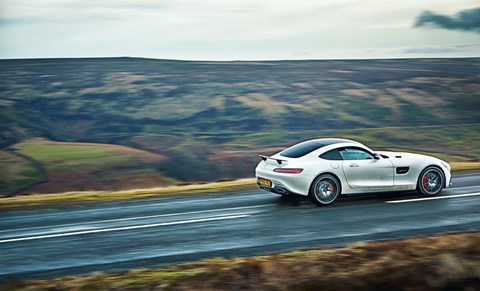
There’s rear-steering this time too, previously reserved for the GT3 and Turbo, and now available as an option on the S (but not the Carrera). On a tight road, where speeds dip below 30mph, you feel it help tuck the nose into corners as the wheels turn the opposite way to the fronts. But up here on Blakey Ridge, where the road runs fast with kinks, not curves, doing the punctuating, you get the stability that comes with the rear wheels turning the same way as the fronts.
There’s no such trickery on the other pair, but the Merc and Jag are impressive in their own ways. Get to grips with that steering and the sheer size of the GT S and it’ll cover ground faster than rainfall when el nino is in town. The damping is excellent, the traction too, a help when it’s freezing and you’re so far from sea level RAF fighters are cutting through the valleys almost at eye level. Switching to Sport Plus tweaks the steering map, building weight and consequently, confidence. Suddenly, the AMG’s back in the game, rectangular pipes dumping decibels in their wake from the turbocharged V8 as it spears past the ramblers filing out of The Lion Inn on the moor’s spine road.
But wait, the burgundy bomber sounds even better, funnelling a properly wicked cackle from its supercharged V8. Steers better too, the fat-rimmed wheel delivering a mix of heft and feel that makes it a real ally. Though the performance figures (Porsche 4.3sec to 62mph, Jag 4.2sec, AMG 3.8sec) say only the slower change from the 911’s manual gearbox prevents the Jag from being the tardiest here, it feels shockingly fast on the move.
Too fast for the rear tyres alone in these conditions, but just like in an old TVR, the hugely long throttle travel helps you mete out the power in sensible chunks – while making you feel like John Cleese performing his Ministry of Silly Walks gag when you stretch to the bulkhead. And if you really want total all-weather confidence, like the 911, the Jag comes optionally with four-wheel drive.
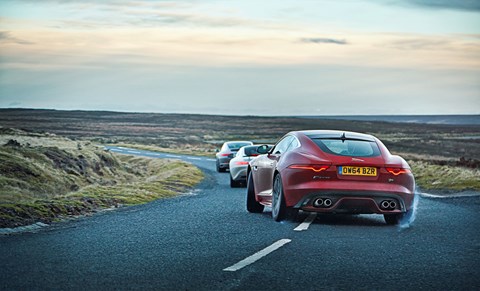
In fact, the F-type does little wrong on the move. The ride can feel a little fidgety, there are times when you can sense the extra weight it’s carrying over the Porsche, and the eight-speed automatic ’box isn’t as swift as the best dual-clutch alternatives, especially during downchanges. But it’s a great coupe, a car that brilliantly straddles the divide between sports car and GT. Last time I drove one in a slightly loaded twin-test, Aston’s fabulous and focused V12 Vantage made it seem slightly soft. In this company it feels poised and polished.
Richard is full of praise for the F-type, which is bad news for the dealer who missed out on a sale by refusing to give him a trade-in deal for his 997 cabrio a couple of years back. He likes the new 911 too, but not enough to think about upgrading. When he bought the AMG, he couldn’t bring himself to part with the 997 and he feels the latest car isn’t different enough to warrant trading up. And within that assertion, one that could sound so negative, is the best news Porsche could hear. That someone who owns a modern naturally aspirated 911 thought the new turbocharged version wasn’t different enough.
No bones about it, there are things about this new 911 engine we like less than we did the old one. You can consider the sports exhaust a pretty essential option, and even then, you still don’t quite get those real top-end notes you used to, as if the noise is running through a hi-fi fitted with a low-pass filter. And there’s that unmistakeable pause when you summon action with the right pedal. But it’s a small pause and the sound is still appealing, voluble and above all, authentic. Of all the cars we’ve driven that have switched from naturally aspirated to turbocharged power, including the Honda Civic Type R and Ferrari’s excellent 488, the 911 comes closest to replicating what it replaces, to maintaining continuity.
From early on in this test one car shone brighter. The 911 does it all. It’s the most practical, the easiest to live with, the cheapest to buy and run. It’s the only one to offer a manual transmission, and the dual-clutch alternative is better than either rival’s ’boxes. But above all it’s the one we wanted to drive again and again. Two decades ago, going water-cooled turned out not to be the end of the world for the 911 after all, and neither has the switch to turbo power. This is a subtly different 911, but it’s still a 911, and a great 911.
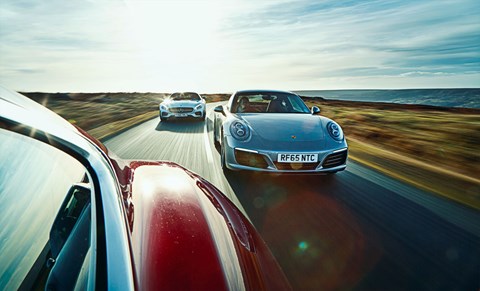
Results
1st: Porsche 911 Carrera S – You trade real-world performance gains for the old car’s intimacy and soundtrack, but this is the best car here. It’s the only car we didn’t want to give back.
2nd: Jaguar F-type R – Loud and lairy yet still with an air of sophistication, the Jag is strong value and hugely fast in the mid range, but it’s not as focused or as fun as the 911.
3rd: Mercedes AMG GT S – Outposes the Porsche, outperforms the Jag, makes the SLS seem like a pricey dinosaur. It’s the car you want in your garage, but not the one you’ll want to take out.
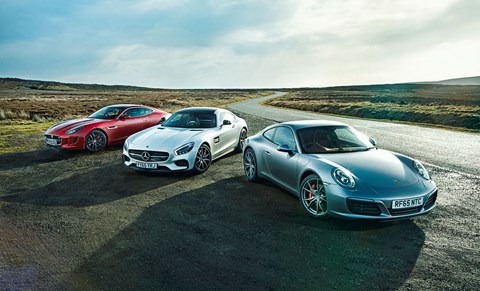
Key tech
911 Carrera S: Connected at last
Porsche’s handsome new standard-fit PCM multimedia system connects with your phone via cable, Bluetooth or Wifi and even works like one, allowing you to pinch and scroll easily on the map screen and offering real-time traffic data. Reasoning that 75% of Porsche buyers have iPhones (and two fingers to the other 25%) it’s fitted Apple CarPlay instead of Android-compatible software. Use your phone’s apps on the move, either via the 7-inch flush-fit touchscreen or voice control.

F-type R: Light, yet heavy?
Jag loves to crow about its aluminium construction in the F-type, but if it’s so great why is the 911 a massive 210kg (the weight of three 11-stone men) lighter despite offering two extra seats? Jag says things like the front-engined car’s prop shaft adds weight. Porsche says it’s because aluminium isn’t always the best choice and using high strength steels with aluminium makes for a strong car that’s both lighter and more space efficient.
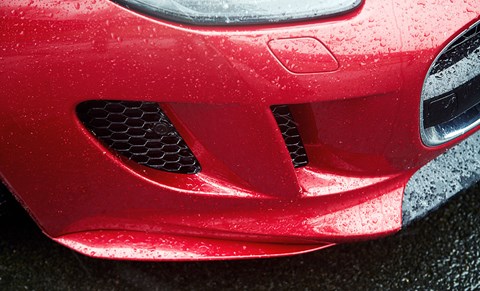
AMG GT S: Tuck in the turbos
AMG’s GT S doesn’t directly replace the old SLS, but the two share more than a role as the halo car in Benz’s range. The biggest difference is the engine, the GT S switching from the SLS’s naturally-aspirated V8 to a blown V8 with the turbochargers tucked in the engine’s vee to contain the width, keep the plumbing sane and promote maximum efficiency. But the steering system, the front suspension, rear-mounted gearbox and the aluminium chassis’ centre section are all carried over.
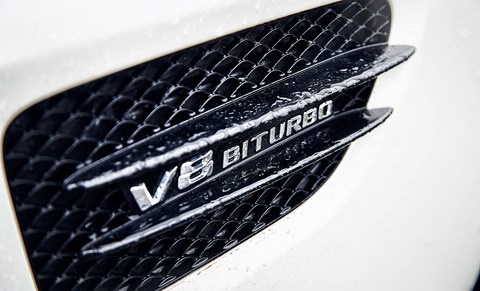
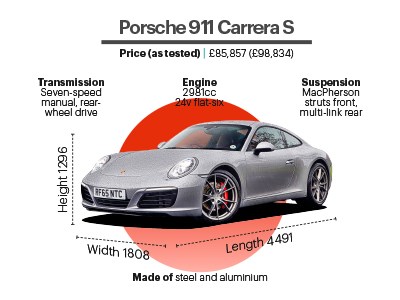
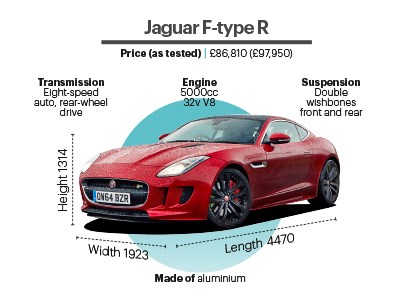
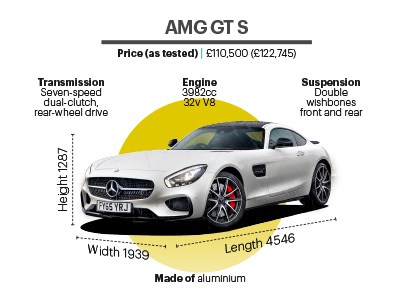
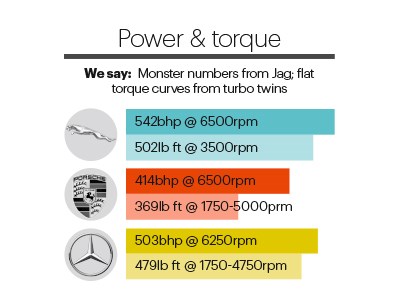
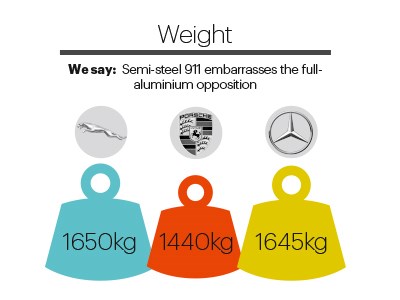
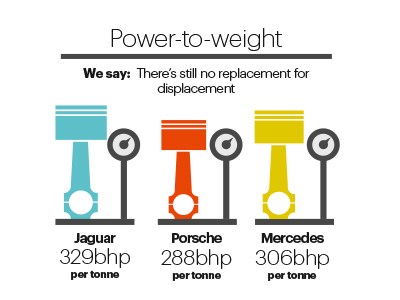
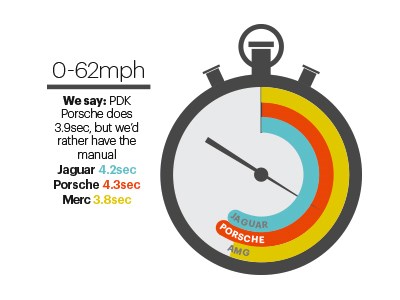


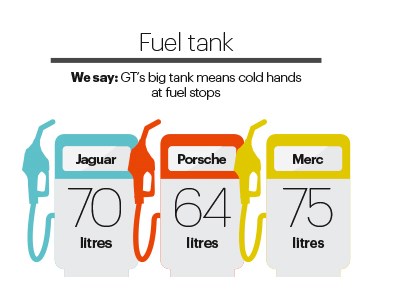

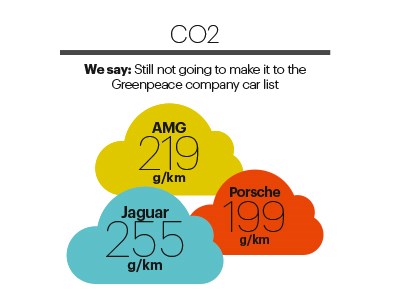
Read more CAR comparison tests